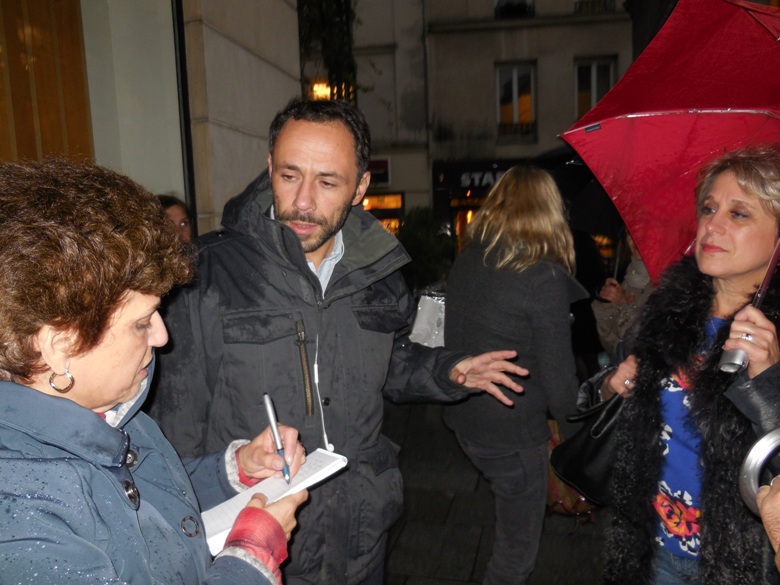Touring Paris, and other cities, with those who live there


Tribune Content Agency
Forget the ubiquitous and delicious French macarons. “Parisians are very keen on eclairs now,” said Edouard Morhange, as he ushers us into a shop called L’Atelier de L’eclair on the rue Bachaumont where all they sell are delectable eclairs — strawberry, caramel, chocolate…
Morhange, who lives nearby and is on the board of the Paris Greeter organization is touring us around this hip, foodie neighborhood close to where Les Halles market existed for generations until it was moved out of the city.
The Les Halles redevelopment project, he shows us, is under way, complete with green space, shops and a reorganized underground road and more functional train station. While the famous shopping mall under the Louvre’s glass pyramid, he explains, is largely used by tourists, this “new heart of Paris” will be largely for locals.
We stop in The Church of St. Eustace at the beginning of rue Montorgueill, which was completed in 1637. Mozart held his mother’s funeral here; Cardinal Richelieu was baptized here. Today, it’s known for its fabulous acoustics — they are getting ready for a concert as we stop in — and the largest pipe organ in France (8,000 pipes) — larger even than that at Notre Dame. But tourists rarely find this amazing place, Morhange tells us.
We’re appropriately awed and thrilled to be seeing a bit of Paris tourists typically miss. The best part is it’s not costing us a penny.
That’s because 360 volunteer Paris Greeters offers some 3,000 free tours every year. There are also free Greeter tours in Versailles and Marseilles and about 30 other French cities. The French,” concedes Morhange, an engaging 40-year-old marketing executive with two kids, “have a reputation of not welcoming tourists. … We want to show that is not the case.” Just sign up online.
Not going to be in Paris? Sign up for a tour with Greeter in the city you’re going to be visiting this holiday season. We had a great time in Lower Manhattan walking across the Brooklyn Bridge with Big Apple Greeter, the first welcome visitor program in the United States that now shows some 7,000 visitors 114 of New York’s neighborhoods.
Take a free tour everywhere from Toronto to Tel-Aviv, Munich to Moscow, London, Zurich, Berlin and Shanghai. In the United States, you’ll also find Chicago Greeter and Houston Greeters.
Paris, a city of about 3 million, gets something like 20 million visitors a year. We saw that firsthand earlier in the day at the Musee D’Orsay — a top tourist draw for their Impressionist and Post-Impressionist collections — with crowds lined up out the door in the rain. I was glad we had the Paris Pass that allowed us to skip those lines!
“A lot of people want to interact with the tourists,” explains Morhange. “They just don’t know how.” Paris Greeters is a way to facilitate that interaction. “It is interesting for the tourists to meet Parisians, adds Morhange, “just as it is interesting for the Parisians to meet the tourists.”
We’ve met at 5 p.m. to tour the Rue Montorgueill, the famous cobblestoned pedestrian street. It proves an especially good choice on this night because we’re staying in an apartment near the Arc de Triomphe at the Hotel Majestic in the residential 16th arrondisement, a short walk from the Champs-Elysees, courtesy of Exclusive Resorts, a private club for digs around the world.

The Exclusive Resorts concierge had offered us all kinds of restaurant suggestions before we even got to Paris, but after a week of multi-course meals on the Avalon River Cruise we’d taken to Normandy — more about that in another column — we tell Morhange we want to shop for takeout for dinner.
He laughs and tells us we’ve come to the right place. Rue Montorgueill is one of Paris’ most famous foodie streets where locals shop for their dinners — so many kinds of cheese — and enjoy an after-work glass of wine or coffee at the many cafes that line the street.
Morhange explains the Rue Montorgueill has historically been a foodie neighborhood because of the proximity of Les Halles, the traditional central market of Paris known, until it was demolished in 1971, as “The Belly of Paris.” “The streets are just like they were in the 19th century,” he said, though today they’re packed with hip Parisians rather than those bringing food to sell at the market.
Morhange points out signs on the buildings, which date back more than a century — one for a shop selling poultry and one for horsemeat. The oldest pastry shop in Paris is here — Stohrer. It was founded in 1730.
We stop at Eric Kayser where Morhange buys his bread. There is a line out the door. Other shops offer everything from ducks (with their heads still on), hundreds of cheeses, delectable chocolates and macarons that come in a rainbow of colors also quiches and the best take-out salads I’ve ever seen.
We opt for rotisserie chicken and potatoes — a typical, quick weekday dinner or Sunday lunch for Parisians, Morhange says.
We stop for a glass of wine at a small cafe called Le Couchon, decorated with painted tiles from the old Les Halles. At the next table, the two men are playing with their pooch — very common in Paris.
We invite Morhange to visit us next time he is in New York; I promise to send his kids one of my city guides for kids.
We head “home” on the Metro clutching a baguette, our chicken and, of course, the eclairs.
Takeout never tasted so good.
(Read my traveldiaries from France at http://ttk-old.o2dev.net/category/travel-diary/)
© 2013 EILEEN OGINTZ, DISTRIBUTED BY TRIBUNE CONTENT AGENCY, LLC.
